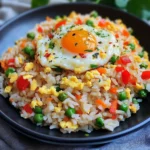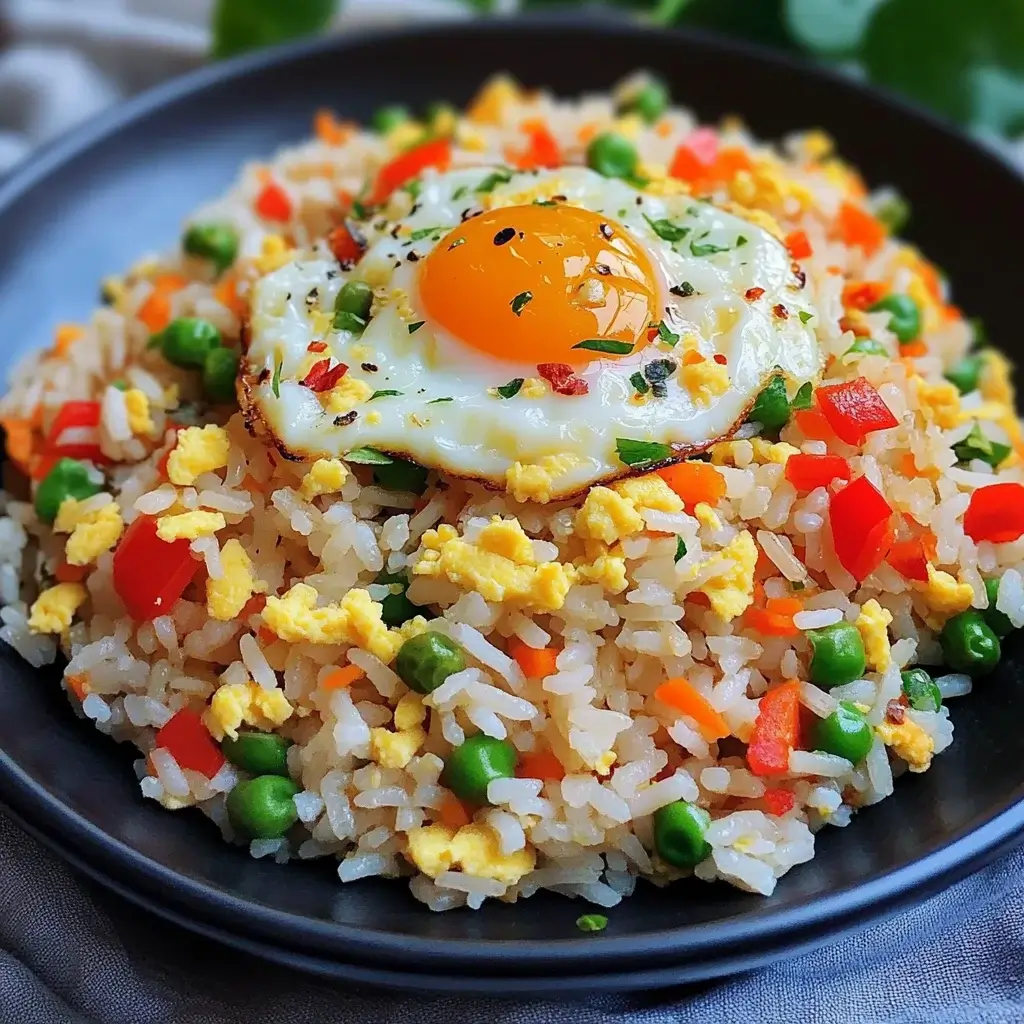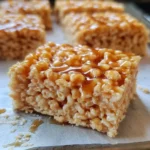My family’s weeknight dinners are often a whirlwind of quick fixes and compromises. Between school runs, homework battles, and the ever-present lure of screens, getting a nutritious and delicious meal on the table can feel like winning a small victory. That’s where this Veggie-Packed Egg Fried Rice recipe has become an absolute lifesaver. It’s not just about speed and convenience, though those are definitely major perks. What truly sets this dish apart is how effortlessly it manages to be both incredibly satisfying and surprisingly healthy. Even my pickiest eaters, who usually eye anything green with suspicion, devour this colorful creation without complaint. The secret, I believe, lies in the perfect harmony of textures and flavors. The slightly chewy rice, the tender-crisp vegetables, the fluffy scrambled egg, all tossed in a savory, umami-rich sauce – it’s a symphony in a bowl. And the best part? It’s endlessly adaptable. Whatever vegetables are lurking in the crisper drawer, whatever dietary preferences we’re catering to that week, this recipe bends and flexes to meet our needs. It’s become a staple, a reliable friend on busy evenings, and a testament to the fact that healthy, delicious, and family-friendly can absolutely coexist.
Ingredients
- Cooked Rice (Day-Old Preferred): 4 cups. The key to perfect fried rice is using day-old cooked rice. This allows the grains to dry out slightly, preventing them from becoming mushy when stir-fried and resulting in a wonderfully chewy texture.
- Eggs: 4 large. Eggs add protein and richness to the fried rice. They are lightly scrambled and then incorporated to create a fluffy and satisfying element in the dish.
- Onion: 1 medium, diced. Onion provides a foundational savory flavor base. Diced finely, it cooks quickly and blends seamlessly into the fried rice.
- Carrots: 2 medium, diced. Carrots add a touch of sweetness, vibrant color, and a satisfying crunch to the fried rice. Dicing them ensures they cook evenly and quickly.
- Frozen Peas: 1 cup. Frozen peas offer a pop of sweetness and bright green color. They are convenient and cook quickly, making them a perfect addition.
- Bell Pepper (any color): 1 medium, diced. Bell peppers bring a slightly sweet and slightly tangy flavor, along with a satisfying crisp-tender texture. The color adds visual appeal to the dish.
- Broccoli Florets: 1 cup, small florets. Broccoli adds a healthy dose of greens and a slightly earthy flavor. Small florets ensure they cook quickly and evenly in the stir-fry.
- Corn Kernels (canned or frozen): 1 cup. Corn adds a burst of sweetness and juicy texture. Canned or frozen corn works equally well for convenience.
- Soy Sauce (low sodium): 1/4 cup. Soy sauce is the primary source of savory, umami flavor in fried rice. Low sodium helps control the salt content while still providing great taste.
- Sesame Oil: 2 tablespoons. Sesame oil imparts a distinctive nutty and aromatic flavor that is essential to authentic fried rice.
- Ginger: 1 tablespoon, minced. Fresh ginger adds a warm, slightly spicy, and aromatic kick that complements the other flavors beautifully.
- Garlic: 2 cloves, minced. Garlic provides a pungent and savory flavor that enhances the overall taste profile of the fried rice.
- Green Onions: 2-3 stalks, thinly sliced. Green onions are used both during cooking and as a garnish. They add a mild oniony flavor and a fresh, vibrant touch.
- Vegetable Oil: 2-3 tablespoons. Vegetable oil is used for stir-frying as it has a high smoke point and neutral flavor, allowing the other ingredients to shine.
- Optional: Chili Flakes: To taste. For those who enjoy a bit of heat, chili flakes can be added to the fried rice for a spicy kick.
Instructions
- Prepare the Rice: If you haven’t already, ensure you have cooked rice that is preferably a day old and cooled. Spreading the freshly cooked rice on a plate and letting it air dry in the refrigerator for a couple of hours (or overnight) is a great way to achieve the ideal texture for fried rice. This process removes excess moisture, preventing the rice from becoming sticky or mushy during stir-frying. Using day-old rice is truly a game-changer for achieving that perfect, slightly chewy texture in your fried rice.
- Prep the Vegetables: While the rice is chilling (or if you’re using pre-chilled rice), prepare all your vegetables. Dice the onion, carrots, and bell pepper into small, uniform pieces. Ensure the broccoli florets are also cut into small, bite-sized pieces. Mince the ginger and garlic finely. Having all your vegetables prepped and ready to go before you start cooking is crucial for efficient stir-frying. Stir-frying is a fast-paced cooking method, and having everything ready at hand will ensure that each vegetable cooks perfectly without overcooking or burning while you are busy chopping.
- Scramble the Eggs: In a small bowl, lightly whisk the eggs with a pinch of salt and pepper. Heat a tablespoon of vegetable oil in a wok or a large skillet over medium heat. Pour in the whisked eggs and cook, stirring gently with a spatula, until they are just set and scrambled. Don’t overcook the eggs; they should be soft and slightly moist. Once cooked, remove the scrambled eggs from the wok and set aside. Cooking the eggs separately ensures they remain tender and fluffy and don’t get mixed in and overcooked with the vegetables and rice later.
- Stir-fry the Aromatics: Add another tablespoon of vegetable oil to the wok or skillet and heat over medium-high heat. Add the diced onion and cook, stirring frequently, until it becomes translucent and softened, about 2-3 minutes. Next, add the minced ginger and garlic to the wok and stir-fry for about 30 seconds, or until fragrant. Be careful not to burn the garlic, as it can become bitter. Sautéing the aromatics first in hot oil releases their flavors and infuses the oil, creating a flavorful base for the entire dish.
- Stir-fry the Vegetables: Add the diced carrots and bell pepper to the wok and stir-fry for 3-4 minutes, until they are slightly tender-crisp. Then, add the broccoli florets and frozen peas (no need to thaw them) and stir-fry for another 2-3 minutes, until the broccoli is bright green and tender-crisp, and the peas are heated through. Finally, add the corn kernels and stir-fry for another minute to warm them up. Stir-frying the vegetables in stages, starting with the harder ones like carrots and bell peppers, ensures that each vegetable is cooked to its ideal tenderness. This sequential addition prevents some vegetables from becoming overcooked while others remain undercooked.
- Add the Rice: Push the vegetables to one side of the wok or skillet, and add the cooked, day-old rice to the empty space. Break up any clumps of rice with your spatula. Pour the soy sauce and sesame oil over the rice. Stir-fry the rice for 2-3 minutes, tossing it constantly to coat it evenly with the soy sauce and sesame oil, and to heat it through. Ensure that the rice is heated through and each grain is separated and coated with the sauce. This step is crucial for creating flavorful and evenly textured fried rice.
- Combine Everything: Bring the vegetables and scrambled eggs back into the wok and gently toss everything together to combine. Stir-fry for another 1-2 minutes to ensure all the ingredients are heated through and well combined. Taste the fried rice and adjust the seasoning if needed. You might want to add a little more soy sauce for saltiness or a dash of chili flakes for heat. The final stir-fry step is to ensure all elements are harmoniously blended and heated, ready for serving.
- Garnish and Serve: Remove the Veggie-Packed Egg Fried Rice from the heat and stir in most of the sliced green onions, reserving some for garnish. Transfer the fried rice to serving bowls and garnish with the remaining green onions. Serve immediately and enjoy your delicious and healthy homemade Veggie-Packed Egg Fried Rice! Serving it hot immediately after cooking ensures the best texture and flavor.
Nutrition Facts
(Per Serving, based on approximately 6 servings)
- Serving Size: Approximately 1.5 cups
- Calories: 350-400 kcal
- Protein: 12-15g
- Fat: 15-20g
Note: Nutrition facts are estimates and can vary based on specific ingredients and portion sizes.
Preparation Time
- Prep Time: 20-25 minutes (for chopping vegetables and preparing ingredients)
- Cook Time: 15-20 minutes (for stir-frying)
- Total Time: 35-45 minutes
This Veggie-Packed Egg Fried Rice is surprisingly quick to make, especially if you have pre-cooked rice on hand. The majority of the preparation time is spent chopping the vegetables, which can be expedited if you use pre-cut vegetables or a food processor for dicing. The actual cooking process is fast and furious, typical of stir-frying, making it a perfect choice for a weeknight meal when time is of the essence. The relatively short total preparation time, combined with the ease of cooking, makes this recipe a winner for busy individuals and families alike.
How to Serve
This versatile Veggie-Packed Egg Fried Rice can be enjoyed in a variety of ways:
- As a Main Course: Enjoy a generous bowl of this fried rice as a satisfying and complete vegetarian meal for lunch or dinner. It’s packed with vegetables, protein from the eggs, and healthy carbohydrates from the rice, making it a balanced and nutritious option.
- As a Side Dish: Serve smaller portions of the fried rice as a flavorful and vibrant side dish alongside other Asian-inspired dishes. It pairs wonderfully with:
- Grilled or baked tofu or tempeh
- Vegetable stir-fries with different sauces (like sweet and sour or black bean sauce)
- Asian-style soups like miso soup or wonton soup
- Spring rolls or vegetable dumplings
- Garnish and Presentation: Enhance the visual appeal and flavor by:
- Sprinkling extra toasted sesame seeds on top for added nutty flavor and texture.
- Adding a fresh garnish of cilantro or chopped parsley for a different herb profile.
- Serving with a drizzle of sriracha or chili oil for those who like a spicy kick.
- Offering a side of extra soy sauce or tamari for those who prefer a saltier taste.
- Meal Prep and Leftovers: This fried rice is excellent for meal prepping. Prepare a large batch and portion it out into containers for quick and easy lunches throughout the week. Leftovers can be stored in the refrigerator for 3-4 days and reheated in the microwave or in a skillet. The flavors often meld together even more beautifully overnight, making it even tastier the next day.
Additional Tips for Perfect Veggie-Packed Egg Fried Rice
- Use Day-Old Rice (Seriously!): This is the golden rule for fried rice. Day-old rice has less moisture, which prevents it from becoming sticky and mushy when stir-fried. Freshly cooked rice is simply too moist and will result in a less desirable texture. Plan ahead and cook your rice a day in advance, or at least a few hours before you plan to make the fried rice.
- High Heat is Your Friend: Stir-frying requires high heat to cook the ingredients quickly and achieve that characteristic wok hei (wok breath) flavor. Make sure your wok or skillet is hot before adding the oil and ingredients. This high heat helps to sear the vegetables and rice, creating slightly crispy edges and preventing them from becoming soggy.
- Don’t Overcrowd the Pan: Overcrowding the pan will lower the temperature and cause the vegetables and rice to steam instead of stir-fry. Cook in batches if necessary, especially if you are doubling the recipe. Giving the ingredients space to move around in the hot pan is crucial for achieving proper stir-fry results.
- Prepare All Ingredients in Advance (Mise en Place): Stir-frying is a fast cooking process. Having all your vegetables chopped, sauces measured, and eggs scrambled before you start cooking is essential for a smooth and efficient cooking experience. This culinary principle of “mise en place” (everything in its place) will make the whole process much less stressful and more enjoyable.
- Customize Your Vegetables: Feel free to get creative and use your favorite vegetables or whatever you have on hand. Other great vegetable additions include:
- Mushrooms (sliced)
- Snap peas or snow peas
- Baby corn
- Water chestnuts
- Edamame (shelled soybeans)
- Spinach or kale (add towards the end of cooking)
- Asparagus (cut into small pieces)
- Zucchini or yellow squash (diced)
The possibilities are endless! This recipe is a fantastic way to use up leftover vegetables and reduce food waste.
- Adjust the Seasoning to Your Taste: Soy sauce is the primary source of saltiness and umami flavor, but you can adjust the amount to your preference. Taste the fried rice towards the end of cooking and add more soy sauce if needed. You can also add other seasonings like:
- Oyster sauce (for non-vegetarian versions, but vegetarian oyster sauce alternatives are available)
- Fish sauce (for non-vegetarian versions)
- Hoisin sauce (for a sweeter and tangier flavor)
- Rice vinegar (for a touch of acidity)
- White pepper (for a subtle heat and different flavor profile)
- A pinch of sugar (to balance the saltiness if needed)
- Don’t Skip the Sesame Oil: Sesame oil is crucial for that authentic fried rice flavor. Its nutty and aromatic notes are what truly elevate the dish. Use toasted sesame oil for the best flavor, but be mindful that it can burn easily, so add it towards the end of the cooking process.
- Consider Adding Protein (Vegetarian Options): While this recipe is already packed with protein from the eggs, you can further boost the protein content by adding other vegetarian protein sources. Good options include:
- Tofu (cubed and pan-fried or baked for a firmer texture)
- Edamame (shelled soybeans, added with the other vegetables)
- Tempeh (crumbled and stir-fried)
- Chickpeas (roasted or pan-fried for a nutty flavor)
- Quorn pieces (vegetarian chicken substitute)
These additions will make the fried rice even more substantial and satisfying as a main meal.
Frequently Asked Questions (FAQ)
- Can I use freshly cooked rice if I don’t have day-old rice?
While day-old rice is highly recommended for the best texture, you can use freshly cooked rice in a pinch. To make it work, spread the freshly cooked rice thinly on a baking sheet and let it cool and dry out slightly for at least 30 minutes to an hour before stir-frying. This will help remove some of the excess moisture. However, the texture will still not be quite as good as using day-old rice. - What other vegetables can I add to this fried rice?
The beauty of fried rice is its versatility! You can add almost any vegetable you like. Great additions include mushrooms, snap peas, snow peas, baby corn, water chestnuts, spinach, kale, asparagus, zucchini, and yellow squash. Get creative and use whatever you have on hand or your favorite vegetables. - Can I make this recipe vegan?
Yes, absolutely! To make this recipe vegan, simply omit the eggs. You can add extra tofu or tempeh for protein if desired. A tofu scramble can also be made separately and added in place of the scrambled eggs for a closer texture and protein replacement. - How long does Veggie-Packed Egg Fried Rice last in the refrigerator?
Properly stored in an airtight container in the refrigerator, Veggie-Packed Egg Fried Rice will last for 3-4 days. Ensure it is cooled down completely before refrigerating it. - Can I freeze fried rice?
Yes, you can freeze fried rice, although the texture of the vegetables and rice might change slightly upon thawing and reheating. To freeze, let the fried rice cool completely, then transfer it to freezer-safe containers or zip-top bags. Freeze for up to 2-3 months. Thaw overnight in the refrigerator or reheat directly from frozen in the microwave or in a skillet with a little oil or water to prevent drying out. - Is this recipe gluten-free?
This recipe can be gluten-free if you use tamari or gluten-free soy sauce instead of regular soy sauce. Soy sauce typically contains wheat, so it’s important to check the label or use a gluten-free alternative if you need to avoid gluten. All other ingredients in this recipe are naturally gluten-free. - How do I prevent my fried rice from becoming soggy?
Several factors contribute to preventing soggy fried rice: using day-old rice, cooking over high heat, not overcrowding the pan, and not adding too much sauce. Ensure your wok or skillet is hot before adding ingredients, cook in batches if necessary, and don’t over-sauce the rice. - Can I add protein other than eggs to this recipe?
Yes! As mentioned in the tips, you can add various vegetarian protein sources to this fried rice. Tofu, tempeh, edamame, chickpeas, and Quorn pieces are all excellent choices. You can pan-fry, bake, or stir-fry these protein sources separately before adding them to the fried rice, or simply add them in with the vegetables during the stir-frying process, depending on the type of protein and desired texture.

Veggie-Packed Egg Fried Rice
Ingredients
- Cooked Rice (Day-Old Preferred): 4 cups. The key to perfect fried rice is using day-old cooked rice. This allows the grains to dry out slightly, preventing them from becoming mushy when stir-fried and resulting in a wonderfully chewy texture.
- Eggs: 4 large. Eggs add protein and richness to the fried rice. They are lightly scrambled and then incorporated to create a fluffy and satisfying element in the dish.
- Onion: 1 medium, diced. Onion provides a foundational savory flavor base. Diced finely, it cooks quickly and blends seamlessly into the fried rice.
- Carrots: 2 medium, diced. Carrots add a touch of sweetness, vibrant color, and a satisfying crunch to the fried rice. Dicing them ensures they cook evenly and quickly.
- Frozen Peas: 1 cup. Frozen peas offer a pop of sweetness and bright green color. They are convenient and cook quickly, making them a perfect addition.
- Bell Pepper (any color): 1 medium, diced. Bell peppers bring a slightly sweet and slightly tangy flavor, along with a satisfying crisp-tender texture. The color adds visual appeal to the dish.
- Broccoli Florets: 1 cup, small florets. Broccoli adds a healthy dose of greens and a slightly earthy flavor. Small florets ensure they cook quickly and evenly in the stir-fry.
- Corn Kernels (canned or frozen): 1 cup. Corn adds a burst of sweetness and juicy texture. Canned or frozen corn works equally well for convenience.
- Soy Sauce (low sodium): 1/4 cup. Soy sauce is the primary source of savory, umami flavor in fried rice. Low sodium helps control the salt content while still providing great taste.
- Sesame Oil: 2 tablespoons. Sesame oil imparts a distinctive nutty and aromatic flavor that is essential to authentic fried rice.
- Ginger: 1 tablespoon, minced. Fresh ginger adds a warm, slightly spicy, and aromatic kick that complements the other flavors beautifully.
- Garlic: 2 cloves, minced. Garlic provides a pungent and savory flavor that enhances the overall taste profile of the fried rice.
- Green Onions: 2-3 stalks, thinly sliced. Green onions are used both during cooking and as a garnish. They add a mild oniony flavor and a fresh, vibrant touch.
- Vegetable Oil: 2-3 tablespoons. Vegetable oil is used for stir-frying as it has a high smoke point and neutral flavor, allowing the other ingredients to shine.
- Optional: Chili Flakes: To taste. For those who enjoy a bit of heat, chili flakes can be added to the fried rice for a spicy kick.
Instructions
- Prepare the Rice: If you haven’t already, ensure you have cooked rice that is preferably a day old and cooled. Spreading the freshly cooked rice on a plate and letting it air dry in the refrigerator for a couple of hours (or overnight) is a great way to achieve the ideal texture for fried rice. This process removes excess moisture, preventing the rice from becoming sticky or mushy during stir-frying. Using day-old rice is truly a game-changer for achieving that perfect, slightly chewy texture in your fried rice.
- Prep the Vegetables: While the rice is chilling (or if you’re using pre-chilled rice), prepare all your vegetables. Dice the onion, carrots, and bell pepper into small, uniform pieces. Ensure the broccoli florets are also cut into small, bite-sized pieces. Mince the ginger and garlic finely. Having all your vegetables prepped and ready to go before you start cooking is crucial for efficient stir-frying. Stir-frying is a fast-paced cooking method, and having everything ready at hand will ensure that each vegetable cooks perfectly without overcooking or burning while you are busy chopping.
- Scramble the Eggs: In a small bowl, lightly whisk the eggs with a pinch of salt and pepper. Heat a tablespoon of vegetable oil in a wok or a large skillet over medium heat. Pour in the whisked eggs and cook, stirring gently with a spatula, until they are just set and scrambled. Don’t overcook the eggs; they should be soft and slightly moist. Once cooked, remove the scrambled eggs from the wok and set aside. Cooking the eggs separately ensures they remain tender and fluffy and don’t get mixed in and overcooked with the vegetables and rice later.
- Stir-fry the Aromatics: Add another tablespoon of vegetable oil to the wok or skillet and heat over medium-high heat. Add the diced onion and cook, stirring frequently, until it becomes translucent and softened, about 2-3 minutes. Next, add the minced ginger and garlic to the wok and stir-fry for about 30 seconds, or until fragrant. Be careful not to burn the garlic, as it can become bitter. Sautéing the aromatics first in hot oil releases their flavors and infuses the oil, creating a flavorful base for the entire dish.
- Stir-fry the Vegetables: Add the diced carrots and bell pepper to the wok and stir-fry for 3-4 minutes, until they are slightly tender-crisp. Then, add the broccoli florets and frozen peas (no need to thaw them) and stir-fry for another 2-3 minutes, until the broccoli is bright green and tender-crisp, and the peas are heated through. Finally, add the corn kernels and stir-fry for another minute to warm them up. Stir-frying the vegetables in stages, starting with the harder ones like carrots and bell peppers, ensures that each vegetable is cooked to its ideal tenderness. This sequential addition prevents some vegetables from becoming overcooked while others remain undercooked.
- Add the Rice: Push the vegetables to one side of the wok or skillet, and add the cooked, day-old rice to the empty space. Break up any clumps of rice with your spatula. Pour the soy sauce and sesame oil over the rice. Stir-fry the rice for 2-3 minutes, tossing it constantly to coat it evenly with the soy sauce and sesame oil, and to heat it through. Ensure that the rice is heated through and each grain is separated and coated with the sauce. This step is crucial for creating flavorful and evenly textured fried rice.
- Combine Everything: Bring the vegetables and scrambled eggs back into the wok and gently toss everything together to combine. Stir-fry for another 1-2 minutes to ensure all the ingredients are heated through and well combined. Taste the fried rice and adjust the seasoning if needed. You might want to add a little more soy sauce for saltiness or a dash of chili flakes for heat. The final stir-fry step is to ensure all elements are harmoniously blended and heated, ready for serving.
- Garnish and Serve: Remove the Veggie-Packed Egg Fried Rice from the heat and stir in most of the sliced green onions, reserving some for garnish. Transfer the fried rice to serving bowls and garnish with the remaining green onions. Serve immediately and enjoy your delicious and healthy homemade Veggie-Packed Egg Fried Rice! Serving it hot immediately after cooking ensures the best texture and flavor.
Nutrition
- Serving Size: one normal portion
- Calories: 400
- Fat: 20g
- Protein: 15g






